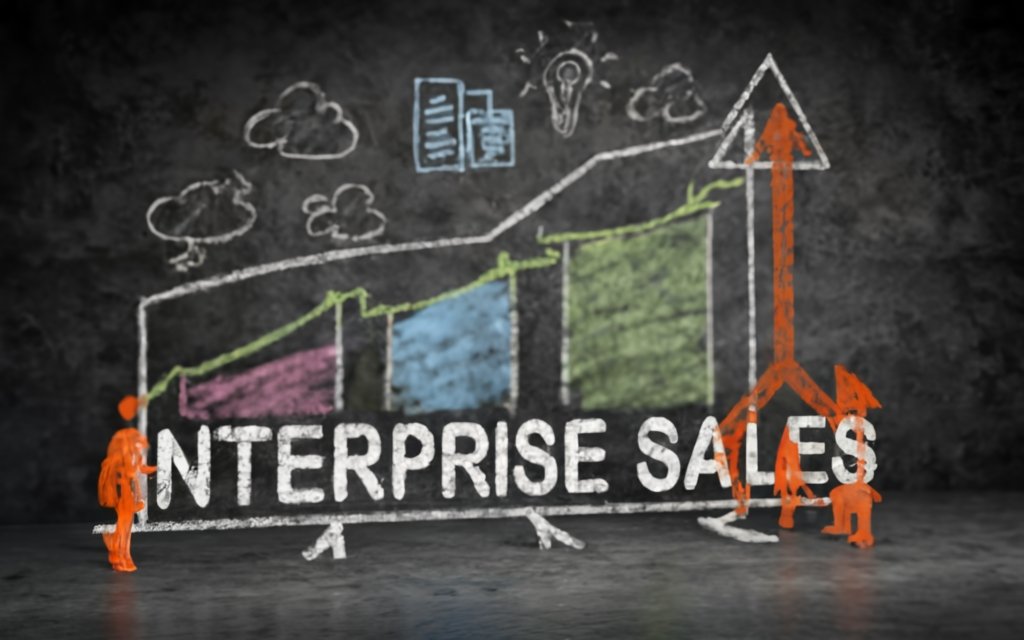For major corporations, enterprise sales is the ultimate game of high-stakes chess. But make the right moves as a trusted advisor – not just a vendor – and checkmate lucrative long-term partnerships.
What is Enterprise Sales?
Defining Enterprise Sales
Enterprise sales refers to the process of selling high-value products and services to large organizations. These deals often involve complex negotiations, tailored solutions, long sales cycles, and multiple stakeholder approvals. In short, enterprise sales is all about highly customized relationships between sales teams and their corporate clients.
So what exactly makes a sale “enterprise”? While there’s no single defining characteristic, enterprise sales typically have these traits:
- High Contract Value: Deals are for large sums of money, often hundreds of thousands to millions of dollars.
- Lengthy Sales Cycle: From initial prospecting to closed deal, the sales process takes multiple months or quarters.
- Multiple Decision Makers: Instead of a single point of contact, enterprise deals require buy-in from various influencers across departments.
- Customized Offerings: Products and services are tailored to the client’s unique needs versus an off-the-shelf solution.
- Complex Implementation: Post-sale onboarding involves extensive configuration, training, and change management.
- High Stakes: Given the investment, vendors undertake rigorous sales processes to mitigate risk on both sides.
So in summary, enterprise sales focus on larger, strategic deals with longer lead times, bigger budgets, and more stakeholder alignment required compared to SMB or mid-market sales. The returns can be tremendous given the deal size, but the complex sales process requires great effort to orchestrate successfully.
How Enterprise Sales Differs from SMB and Mid-Market Sales
It’s easy to understand the difference between enterprise sales versus SMB/mid-market sales when you consider these core factors:
Buyer Motivations
SMB buyers are focused on solving immediate tactical pains or singular departmental issues. Enterprise buyers think about long-term strategic goals, competitive pressures, and company-wide objectives.
Purchasing Authority
At smaller companies, decisions may come down to just the owner or a department head. Large enterprises have formal processes requiring sign-offs from multiple divisions.
Sales Cycle Duration
SMB sales cycles tend to be short, often concluding deals within weeks or a few months. For enterprises, it’s not uncommon for sales cycles to last 6-12 months from initial contact to closed contract.
Deal Complexity
Enterprise deals have greater workflow, system integration, change management, and service-level agreement considerations given the scale. SMB solutions can be simpler “out-of-the-box” setups.
More touchpoints and relationship nurturing is required for enterprise accounts to coordinate sales activities across various stakeholders. SMBs have fewer people involved.
Pricing and Contracts
From lengthy negotiations to custom billing terms, enterprise deal paperwork is a heavyweight affair. SMB transactions tend to use simpler standardized contracts.
After-Sales Support
The ongoing service needs of enterprises necessitates dedicated account management and customer success teams. SMBs require less hand-holding post-purchase.
Brand Positioning
Landing mega enterprise clients provides great credibility in promoting your solution to future prospects. It’s less impactful selling to smaller firms.
So in summary, successfully selling at the enterprise level requires much greater investment in sales processes, staff, and infrastructure compared to SMB segments. But the payoff can be transformational in terms of deal size, perceived brand value, and long-term revenue potential.
Types of Enterprise Sales Models
While each company tailors strategies to their offering and strengths, these are some of the most common enterprise sales models:
Direct Sales
The vendor’s sales team sells directly to clients using field sales reps, inside sales staff, and sales engineers. Account executives develop relationships and handle the entire sales cycle.
Channel Sales
Instead of a direct salesforce, the vendor relies on resellers, distributors, systems integrators, and channel partners to sell its solutions. This leverages partners’ customer relationships.
Self-Service
The vendor provides resources like demos, free trials, docs, and pricing online for prospects to educate themselves and purchase directly. Minimal sales assistance unless requested.
Specialist Sales
For complex technical solutions, pre-sales solutions architects and engineers demo capabilities, provide quotes, and guide technical evaluations throughout the sales cycle.
A dedicated team focuses on selling into existing accounts and upselling additional offerings once customers are onboarded, also known as farm or harvest sales.
The model each company chooses depends on factors like product complexity, target customer size, required sales touchpoints, and internal resources. Most combine approaches based on deal specifics. But fundamental enterprise sales processes remain consistent, if adapted to company strengths.

The Enterprise Sales Process Step-by-Step
Now that we’ve defined enterprise sales, let’s walk through the typical sales process stages when engaging with corporate prospects. Understanding the milestones, activities, and goals of each phase will help sales teams execute smoothly.
Prospecting & Lead Generation
The first step is filling your pipeline with promising new accounts to target. Sales prospecting involves research and outreach to identify potential opportunities.
For enterprise deals, focus on accounts matching your ideal customer profile – factors like industry, size, tech stack, business model, etc. Leverage sales intelligence tools to filter your total addressable market and pinpoint the best accounts to prioritize.
Outbound prospecting techniques include:
- Cold emailing and cold calling into target accounts
- Networking at industry events to connect with decision-makers
- Running targeted ad campaigns to engage key personas
- Monitoring social media for triggers indicating a potential need
You can also generate inbound leads through your website, content marketing, referrals, and other touchpoints.
To maximize your chances, blend outbound and inbound lead generation. The goal is to efficiently fill your funnel with qualified accounts to nurture towards a sale.
Initial Research & Discovery Questions
Now it’s time to directly engage your prospects through calls, emails, or meetings. With enterprise deals, you first need to map out the company’s structure, stakeholders, pain points, and priorities.
Critical discovery questions include:
- Who are the key decision makers and influencers?
- What are their current challenges and goals?
- How do they evaluate and select vendors?
- When are they looking to make a purchase?
- What is their budget?
- Who are their current vendors/partners?
Take the time upfront to thoroughly understand their expected timelines, budget parameters, competitor landscape, and technical requirements. The buyer’s journey can be complex evaluating an enterprise-wide implementation.
This discovery process allows you to create an initial proposal addressing their needs. But expect much more two-way dialogue before finalizing a solution.
Identifying Pain Points & Qualifying Leads
Now it’s time to have more strategic conversations about diagnosing their business issues and goals. You want to transition the discussion from generic vendor selection to uncovering their deeper challenges requiring a robust solution.
Common pain point discussions may explore:
- Where are inefficiencies in current workflows?
- What challenges come with supporting complex integrations?
- How quickly can they deliver new capabilities to customers?
- Do they have full visibility into sales data and analytics?
- What risks keep them up at night about daily operations?
This helps pinpoint strategic areas for improvement tied to concrete ROI. You can then have informed discussions on key performance indicators to measure solution success.
Once you’ve identified compelling focus areas, qualify the opportunity using lead scoring criteria. Factors may include deal size, timeline, competition, budget status, authority of contacts, needs alignment, and solution fit.
Prioritize leads strategically based on revenue potential versus effort required. This ensures you focus sales activities on the most promising accounts.
Crafting Tailored Solutions
Now that you grasp their needs from discovery conversations, it’s time to shape a tailored solution.
This consultative process may involve:
- Collaborating with technical teams on capabilities and integrations
- Conducting product demos for different users and use cases
- Creating customized pilots addressing key scenarios
- Building ROI models quantifying the potential business impact
- Ensuring compliance with regulations or security protocols
You want to demonstrate deep understanding of their workflows, systems, and constraints. The goal is positioning your offering as an extension of their environment versus an add-on.
For large deals, you may engage with customers for many weeks or months to refine the scope. Expect ongoing dialogue, not a one-and-done proposal.
Presenting Solutions & Handling Objections
Once you’ve aligned on a plan of attack, it’s time to present the complete solution and discuss final logistics.
Areas to cover include:
- Walk through the statement of work and contract terms
- Provide detailed pricing breakdowns and financing options
- Explain the implementation roadmap and rollout schedule
- Introduce the delivery team and account management approach
- Share case studies from similar deployments and integrations
- Provide SLAs, performance metrics, and measurement plans
Expect thorough Q&A, as stakeholders evaluate how the solution impacts their individual goals and users. Technical leaders will validate capabilities, IT will review security protocols, and execs will confirm ROI and total cost of ownership.
Address any objections head on with data, validate concerns, and gauge flexibility where possible. Maintaining momentum is critical through this political process.
Identify known blockers early, and keep allies engaged to create pull for the solution. The presentation stage is critical in aligning players to drive the deal forward.
Contract Negotiations & Securing the Deal
As contract negotiations kick off, anticipate that the legal and procurement teams will get heavily involved. These groups will conduct financial reviews and tightly scrutinize terms.
To maintain goodwill:
- Be transparent on constraints and flexibilities from the start
- Share templates early so teams align on standards upfront
- Clarify processes for resolving disputes down the line
- Accommodate requests that are reasonable
Once paperwork is signed, you’ve secured the customer! But implementation planning should start ASAP while energy is high. Delaying too long post-signature risks eroding momentum.
Which leads us to…
Onboarding & Ensuring Ongoing Success
Congratulations, your enterprise customer is now ready to roll out. The transition from sales to activation is the sticky part.
Smart onboarding ensures continued excitement after the contract high by:
- Introducing implementation team members
- Scheduling extensive training programs
- Developing staged rollout plans and pilots
- Defining measures of success and key results
- Monitoring usage closely and intervening at signs of lag
Don’t just paper over problems and hope things stick. Be proactive through the implementation process until the customer sees full value realization.
On an ongoing basis, nurture the account through regular check-ins, health scoring, customer satisfaction surveys, and revisiting success metrics. Your work continues through ongoing account management and relationship expansion.
In short
Navigating all the phases of the enterprise sales cycle takes great skill. But methodically guiding customers from prospect to advocate can transform your business. While complex, mastering enterprise sales unlocks tremendous revenue potential and lasting customer relationships.

Creating an Enterprise Sales Team
Building a stellar enterprise sales team is critical to executing smoothly through complex deal cycles. The specialized skills and relentless effort required need dedicated teams focused exclusively on corporate accounts.
Hiring the Right Skills & Experience
Because the sales process is so multifaceted, enterprise teams need a diverse mix of capabilities:
Relationship Builders: Can cultivate C-level relationships and navigate corporate politics to gain buy-in across stakeholders.
Strategic Consultants: Analyze business needs in depth to shape tailored solutions versus one-size-fits-all pitches.
Technical Experts: Provide demos showcasing how the platform aligns to IT landscapes and enterprise architectures.
Quant Jocks: Create ROI models, develop pricing, and present analytical evidence supporting the investment.
Project Managers: Drive intricate implementation plans blending company resources and external teams.
Customer Advocates: Manage complex accounts long-term, ensuring satisfaction during rollouts and renewals.
Look for team members with formal enterprise sales training and a proven track record closing lucrative deals. Domain expertise in your industry vertical also provides credibility with corporate prospects.
Structuring the Team & Defining Roles
Given the many specialties involved, smart structure and coordination is key. Best practices include:
Specialized Functions: Create roles around key competencies like technical sales, business analysts, implementation experts.
Shared Goals: Maintain collective focus on customer lifetime value and company strategic priorities versus individual quotas.
Defined Playbooks: Document winning strategies for each sales cycle milestone to enable consistency.
Accountability: Assign clear owners throughout the complex sales process for strong execution.
Cross-Training: Get team members educated on the wider sales cycle and how their role contributes to overall deal success.
With optimized enterprise sales teams, the orchestrated contributions of all players intersect to deliver outstanding buying experiences, deal after deal.
Providing Ongoing Training & Development
The enterprise landscape evolves quickly as new technologies, regulations, and customer expectations constantly shift. Sales teams need continual learning opportunities to stay razor-sharp.
Training priorities include:
- Product releases, new features, and technical capabilities
- Changing customer needs and pain points by industry
- Competitor offerings and differentiation strategies
- New sales tools, methodologies, and best practices
- Leadership, negotiation, and relationship-building skills
Make training ongoing through regular workshops, digital learning modules, certifications, and skills coaching. And don’t neglect soft skills given the relationship aspect of enterprise sales.
Top teams never stop improving across the board.
Using Technology to Enhance Productivity
Nothing kills enterprise deals faster than sales teams dropping the ball through lack of coordination. Technology plays a pivotal role keeping everyone aligned.
- CRM: Centralize prospect data, activity history, account planning, opportunity status.
- Playbooks: Provide guided selling checklists for each milestone to standardize excellence.
- Analytics: Surface insights around lead sources, sales cycle trends, forecasting to optimize activities.
- Marketing Automation: Trigger targeted nurture campaigns for prospects based on behaviors and scores.
- Sales Engagement: Arm reps with cadences and sequences to execute consistent multichannel outreach.
Leveraging sales technology enables strategic account management at scale. Orchestrate the orchestra to create sales harmony.
Measuring the Success of Enterprise Sales
What gets measured gets managed. Metrics provide the visibility needed to continually refine and improve enterprise sales performance.
Tracking Sales Performance Metrics
Key indicators to quantify sales effectiveness include:
Win Rate: Percentage of proposals accepted versus proposals submitted. Demonstrates pricing and competitive positioning prowess.
Average Deal Size: Total contract value divided by number of deals. Indicates success cultivating large accounts and selling breadth of solutions.
Sales Cycle Length: Time from prospecting to closed deal. Longer cycles signal inefficient sales motions.
Proposal Value vs Budgets: How proposed pricing compares to original budgets. Exceeding budgets indicates sales created more value.
Recurring Revenue: Revenue from ongoing multi-year contracts versus one-time deals. Critical for predictable forecasting.
Analyzing performance metrics enables sales leaders to pinpoint what behaviors and activities drive success to replicate across the team. Measure what matters most.
Monitoring Customer Lifetime Value
The CLV formula sums projected revenue from a client over the entire customer relationship, factoring in retention rates and expansion opportunities. This predictive metric spotlights your most valuable accounts.
Marketing and sales initiatives should nurture maximum CLV growth by:
- Reducing customer churn through education, support, and satisfaction monitoring
- Upselling additional licenses, products, or premium packages over time
- Cross-selling expanded offerings across departments
- Referring partners and integration opportunities
- Transitioning clients to higher-tier enterprise pricing packages
Sustained CLV boosts prove sales teams are partnering effectively to maximize share of wallet.
Analyzing Sales Funnel Velocity & Conversion
Two key metrics diagnose where enterprise deals get stuck in the sales funnel:
Velocity: Time deals spend in each sales stage. Longer phases signal inefficient hand-offs or unclear buyer expectations.
Conversion Rate: Percentage of deals progressing to the next stage versus dropping out or stalling. Low conversion warns of poor lead quality or ineffective sales motions.
Comparing velocity and conversion rates by stage highlights problem areas. Use those insights to reduce bottlenecks and accelerate pipeline throughput.
Optimizing Based on Data & Analytics
Advanced analytics transform sales metrics into action. Examples include:
- Lead scoring models identifying your hottest prospects for prioritization
- Predictive models forecasting deals most likely to close or churn
- ROI dashboards showcasing cost and payback of various sales programs
- Activity metrics revealing engagement tactics that advance deals
- Competitive win/loss analysis spotlighting strengths or improvement areas
Data-driven enterprise sales teams apply intelligence to continually refine sales processes, account targeting, and resource allocation. Let data guide your way.
The bottom line? Metrics provide the ground truth about what’s working (and what’s not) in complex enterprise sales pursuits. Master measurement to boost performance.

FAQs About Enterprise Sales
Let’s explore some frequent questions that come up when managing complex enterprise sales pursuits:
What are common challenges in enterprise sales?
The intricate nature of enterprise deals comes with inherent challenges including:
- Long sales cycles requiring persistence and disciplined follow-up over months
- Multiple decision makers across various functions needing alignment
- Higher risk given the stakes of major business investments
- Custom requirements necessitating tailored solutions vs off-the-shelf
- Fierce competition from vendors vying for lucrative contracts
- Higher complexity integrating with legacy systems and workflows
- Rigorous legal processes around contract terms and liability management
- Resource intensive with large sales teams required to coordinate efforts
- Higher pressure with large deals at stake and lengthy cycles invested
But the rewards of overcoming these hurdles are deals that can be game-changers for growth.
How long does the average enterprise sales cycle take?
The complete end-to-end sales cycle typically spans:
- 2-4 weeks for discovery conversations
- 2-3 months crafting detailed solutions
- 1-2 months negotiating terms and pricing
- 2+ months post-sale for implementation
So on average, enterprise deals take 6-12 months from prospecting to going live. Complex sales are marathons, not sprints. having the patience and resilience to persist is key.
What tools can help manage enterprise sales?
Technology is essential for orchestrating the many moving parts of enterprise deals. Handy platforms include:
- CRM: Centralizes prospect/account data, interactions, documents, and pipeline visibility.
- Sales Engagement: Automates multichannel touchpoints through sequences and playbooks.
- Proposal Software: Enables collaborative proposal development and customization.
- Sales Analytics: Surfaces intelligence around pipeline trends, forecasts, conversions, etc.
- Account Mapping: Visualizes relationships between contacts and buying process.
- Sales Training Software: Drives continuous skills development and best practice usage.
The right technology stack provides visibility and consistency needed to excel in complex sales.
How does enterprise sales differ from inside sales or field sales?
While enterprise sellers use both inside and field sales tactics, the core difference is the strategic nature of relationships and solutions:
- Inside sales focuses on higher volume lead follow-up and closing smaller deals.
- Field sales meets face-to-face with prospects to build relationships.
- Enterprise sales spots big picture gaps to shape long-term partnerships and deliver business transformation.
So enterprise sellers certainly employ tactics from both models. But the differentiated value they provide is strategic vision leading to highly customized, long-term deals aligned to corporate objectives. They are partners versus vendors. This consultative positioning is what sets enterprise sales apart.
Other Frequently Asked Questions :
What is the difference between enterprise sales and transactional sales?
Transactional sales focus on high-volume sales of lower-priced products or services. Enterprise sales pursue highly complex, customized, long-term partnerships with large corporate clients involving extensive negotiations.
How long do enterprise sales cycles typically last?
From initial prospecting through deal closure, enterprise sales often last 6-12 months. The long timeframes come from thoroughly understanding needs, shaping tailored solutions, navigating corporate bureaucracy, and coordinating detailed implementation plans.
What makes enterprise sales so complicated?
Complexity comes from selling across multiple departments, aligning many different stakeholders, undergoing rigorous legal reviews, managing high-risk major investments, integrating with complex systems, and providing dedicated onboarding and support.
How can sales teams effectively manage long enterprise sales cycles?
Patience and discipline are key. Maintain momentum through calculated actions like discovery questions early on, stakeholder relationship-building throughout, relevant content nurturing, and celebrating small wins along the way.
What types of professionals are best suited for enterprise sales roles?
Enterprises require strategic thinkers who can analyze business gaps, prove ROI, and synthesize solutions. Look for experience with long sales cycles, technical aptitude, project management skills, industry knowledge, and ability to coordinate cross-functional groups.
Why invest extra resources required for enterprise sales pursuits?
Despite greater complexities, enterprise deals provide game-changing revenue potential from lucrative long-term contracts. Enterprise clients also enhance credibility and opportunities to expand share-of-wallet over time through upsells and cross-sells.
How should sales leaders measure and optimize enterprise sales success?
Key performance metrics to track include deal velocity through sales stages, win rates for proposals, recurring revenue rates, customer lifetime value, and sales forecasting models. Use data-driven insights to continually refine strategies.
What sales technologies are most impactful for managing enterprise deals?
Platforms like CRM, sales engagement, proposal software, sales analytics, account mapping and sales training software provide the visibility, consistency, and productivity needed to orchestrate complex sales at scale.
Summary
Enterprise sales deals are complex, but mastering this process opens doors to tremendous revenue potential. Here are some key lessons:
- Enterprise sales focus on highly customized, long-term partnerships with large corporate clients involving complex negotiations.
- Take time upfront during discovery conversations to thoroughly understand all stakeholder needs, challenges, priorities and processes.
- Build relationships across the organization by tailoring messaging and solutions to different buying personas and influencers.
- Present a strategic vision for how your solution not just fixes immediate problems but transforms capabilities and enables growth.
- Leverage case studies and customer stories to showcase real-world examples of delivering value for companies like theirs.
- Hire specialized enterprise sales teams with the diverse expertise needed to map accounts, shape solutions, prove ROI, and manage intricate deployments.
- Apply sales technologies like CRM, analytics, and sales engagement tools to enable consistent processes and enhanced productivity.
- Customize proposals, contracts, onboarding plans and post-sale support to provide an outstanding buying experience matching enterprise expectations.
- Monitor metrics like sales cycle trends, win rates, recurring revenue, and customer lifetime value to continuously improve.
Though complex, a meticulous enterprise sales process can align organizations around your solution to develop loyal customers and unlock major revenue potential.

